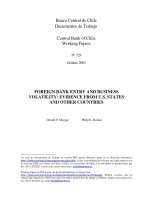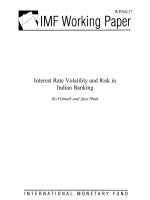CH16 volatility smiles
Bạn đang xem bản rút gọn của tài liệu. Xem và tải ngay bản đầy đủ của tài liệu tại đây (283.25 KB, 13 trang )
16.1
Volatility Smiles
Chapter 16
16.2
Put-Call Parity Arguments
Put-call parity p +S
0
e
-qT
= c +K e
–r T
holds regardless of the
assumptions made about the stock price distribution
It follows that
p
mkt
-p
bs
=c
mkt
-c
bs
16.3
Implied Volatilities
When p
bs
=p
mkt
, it must be true that c
bs
=c
mkt
It follows that the implied volatility calculated from a European call option
should be the same as that calculated from a European put option when
both have the same strike price and maturity
The same is approximately true of American options
16.4
Volatility Smile
A volatility smile shows the variation of the implied volatility with the
strike price
The volatility smile should be the same whether calculated from call
options or put options
16.5
The Volatility Smile for Foreign Currency Options
(Figure 16.1, page 377)
Implied
Volatility
Strike
Price
16.6
Implied Distribution for Foreign Currency Options (Figure 16.2, page
377)
Both tails are heavier than the lognormal distribution
It is also “more peaked” than the lognormal distribution
16.7
The Volatility Smile for Equity Options (Figure 16.3, page 380)
Implied
Volatility
Strike
Price
16.8
Implied Distribution for Equity Options (Figure 16.4, page 380)
The left tail is heavier and the right tail is less heavy than the
lognormal distribution
16.9
Other Volatility Smiles?
What is the volatility smile if
True distribution has a less heavy left tail and heavier right tail
True distribution has both a less heavy left tail and a less heavy right tail
16.10
Possible Causes of Volatility Smile
Asset price exhibiting jumps rather than continuous change
Volatility for asset price being stochastic
(One reason for a stochastic volatility in the case of equities is the
relationship between volatility and leverage)
16.11
Volatility Term Structure
In addition to calculating a volatility smile, traders also calculate a volatility
term structure
This shows the variation of implied volatility with the time to maturity of the
option
16.12
Volatility Term Structure
The volatility term structure tends to be downward sloping when volatility
is high and upward sloping when it is low
16.13
Example of a Volatility Surface
(Table 16.2, page 382)
Strike Price
0.90 0.95 1.00 1.05 1.10
1 mnth 14.2 13.0 12.0 13.1 14.5
3 mnth 14.0 13.0 12.0 13.1 14.2
6 mnth 14.1 13.3 12.5 13.4 14.3
1 year 14.7 14.0 13.5 14.0 14.8
2 year 15.0 14.4 14.0 14.5 15.1
5 year 14.8 14.6 14.4 14.7 15.0









